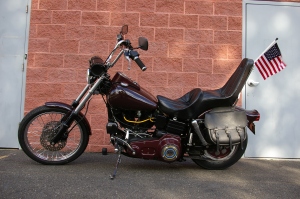By Bud Wilkinson of RIDE-CT.com
It looks much older than it actually is. From the vantage point of “a man of a certain age,” a  vintage motorcycle is one from the 1930s, 1940s or maybe 1950s – not 1983. Somehow, though, the purple Harley-Davidson FXDG recently restored by Doc’s Motorcycle Parts in Waterbury looks older than 27 years. Compared with the lines and finish of new Harleys, the FXDG is stunningly prehistoric. It appears at once solid yet easily breakable, a bike with a lot of character but possible osteoporosis, a bike that only guys rode back then because they knew how to fix them.
vintage motorcycle is one from the 1930s, 1940s or maybe 1950s – not 1983. Somehow, though, the purple Harley-Davidson FXDG recently restored by Doc’s Motorcycle Parts in Waterbury looks older than 27 years. Compared with the lines and finish of new Harleys, the FXDG is stunningly prehistoric. It appears at once solid yet easily breakable, a bike with a lot of character but possible osteoporosis, a bike that only guys rode back then because they knew how to fix them.
The FXDG belongs to Brian Chesma of Waterford, who bought it new and put 39,419 miles on it before bringing it to Doc’s in August for an overhaul. “The motor was kind of shot. We had to rebuild it. It was kind of a three-quarter restoration. A lot of the cosmetic stuff – the tanks, the tins – was worn off or not finished,” said Mike “Doc” D’Occhio, vice president of the motorcycle parts and service store.
It took a team resuscitate the FXDG. Lee Farley, Doc’s general manager, and Bob Cole hunted down parts, Greg Wellnitz handled disassembly and assembly, and Mark DiPietro oversaw the wiring. Doc’s went outside the company and tapped Bob Fernandez to do the engine rebuild. Fernandez has attained legendary status in these parts when it comes to knowing the intricacies of old Harleys. John Baltera did the paint and Precision Powder Coating the engine covers.
The FXDG is rare, which is why RIDE-CT chose to spotlight it. It was a one-year model that was designed by Willie G. Davidson. Only 900 were built and, according to unverified information found online, only 700 were sold in the United States. The other 200 were reportedly exported.
The “DG” stands for “Disk Glide,” a reference to the solid rear wheel. “It was the first Harley to use a solid rear wheel,” said Farley. The FXDG retained a traditional spoke wheel up front. “The bike was only painted one color. There were no color options,” added Farley, who estimated that he spent 16 hours searching online and elsewhere for parts, “just trying to find odd items.” D’Occhio added, “Our painter did his best to match the original color scheme from Harley.”
Some parts were unavailable in sufficient numbers. Farley reported that he was only able to find one original brake rotor and one original decal. “The decals are specific to that bike,” he said. Consequently, the gas tank remains bare.
D’Occhio reported that Doc’s takes on projects such as the FXDG, it’s not for the money but for the challenge. “When a customer comes in and asks you do to it, it holds a special place. The customer’s going to be riding it. It’s a challenge because you want to meet the expectations the customer has,” he said.
While time spent in the shop working on the bike like the FXDG is billable, the hours spent on research aren’t. “From a profit standpoint, we’re not doing it for the profit. You’re not doing it to make a lot of money,” said D’Occhio. “When you can do a project like this and not lose money, it’s a positive.”
While no one at Doc’s would disclose the total cost of project in dollars, suffice to say that the price tag was as much as a new full-sized Harley would cost.
(Originally published October 23, 2010 in “The Republican-American” newspaper.)
 Ride CT & Ride New England Serving New England, NYC and The Hudson Valley!
Ride CT & Ride New England Serving New England, NYC and The Hudson Valley!


Doc’s, I have an fxdg that I have been restoring for about 2 1/2 years. It has 16,225 miles and I found it in a garage in Cape Cod in about 10 boxes. I have been searching for the special parts for that long. You got off easy! but I am totally committed to the restoration. It is definitely not a profit build but a dedication to an important bike from a historic time.